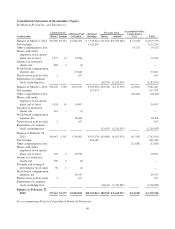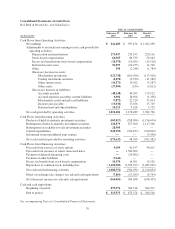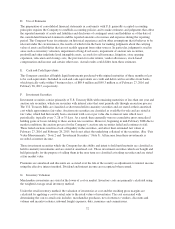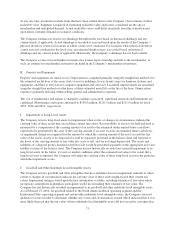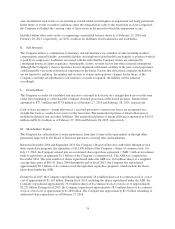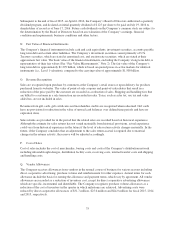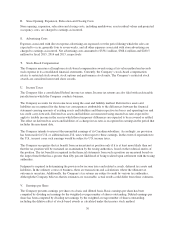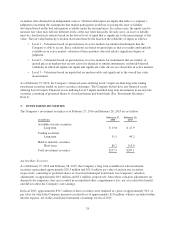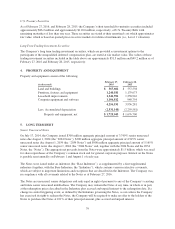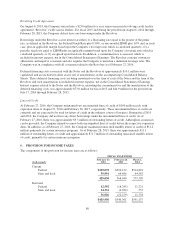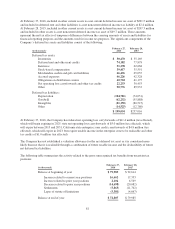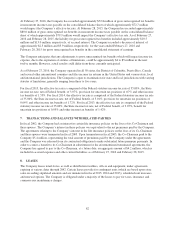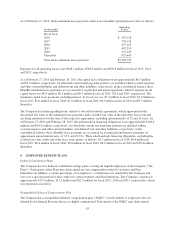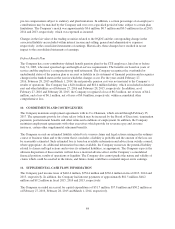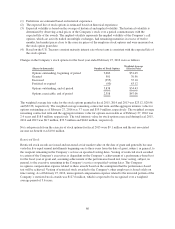Bed, Bath and Beyond 2015 Annual Report Download - page 88
Download and view the complete annual report
Please find page 88 of the 2015 Bed, Bath and Beyond annual report below. You can navigate through the pages in the report by either clicking on the pages listed below, or by using the keyword search tool below to find specific information within the annual report.R. Store Opening, Expansion, Relocation and Closing Costs
Store opening, expansion, relocation and closing costs, including markdowns, asset residual values and projected
occupancy costs, are charged to earnings as incurred.
S. Advertising Costs
Expenses associated with direct response advertising are expensed over the period during which the sales are
expected to occur, generally four to seven weeks, and all other expenses associated with store advertising are
charged to earnings as incurred. Net advertising costs amounted to $338.1 million, $308.4 million and $280.5
million for fiscal 2015, 2014 and 2013, respectively.
T. Stock-Based Compensation
The Company measures all employee stock-based compensation awards using a fair value method and records
such expense in its consolidated financial statements. Currently, the Company’s stock-based compensation
relates to restricted stock awards, stock options and performance stock units. The Company’s restricted stock
awards are considered nonvested share awards.
U. Income Taxes
The Company files a consolidated Federal income tax return. Income tax returns are also filed with each taxable
jurisdiction in which the Company conducts business.
The Company accounts for its income taxes using the asset and liability method. Deferred tax assets and
liabilities are recognized for the future tax consequences attributable to the differences between the financial
statement carrying amounts of existing assets and liabilities and their respective tax bases and operating loss and
tax credit carry-forwards. Deferred tax assets and liabilities are measured using enacted tax rates expected to
apply to taxable income in the year in which those temporary differences are expected to be recovered or settled.
The effect on deferred tax assets and liabilities of a change in tax rates is recognized in earnings in the period that
includes the enactment date.
The Company intends to reinvest the unremitted earnings of its Canadian subsidiary. Accordingly, no provision
has been made for U.S. or additional non-U.S. taxes with respect to these earnings. In the event of repatriation to
the U.S., in most cases such earnings would be subject to U.S. income taxes.
The Company recognizes the tax benefit from an uncertain tax position only if it is at least more likely than not
that the tax position will be sustained on examination by the taxing authorities, based on the technical merits of
the position. The tax benefits recognized in the financial statements from such a position are measured based on
the largest benefit that has a greater than fifty percent likelihood of being realized upon settlement with the taxing
authorities.
Judgment is required in determining the provision for income taxes and related accruals, deferred tax assets and
liabilities. In the ordinary course of business, there are transactions and calculations where the ultimate tax
outcome is uncertain. Additionally, the Company’s tax returns are subject to audit by various tax authorities.
Although the Company believes that its estimates are reasonable, actual results could differ from these estimates.
V. Earnings per Share
The Company presents earnings per share on a basic and diluted basis. Basic earnings per share has been
computed by dividing net earnings by the weighted average number of shares outstanding. Diluted earnings per
share has been computed by dividing net earnings by the weighted average number of shares outstanding,
including the dilutive effect of stock-based awards as calculated under the treasury stock method.
76





